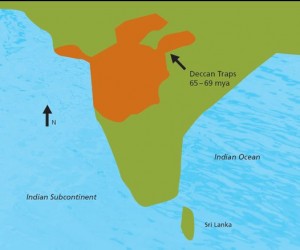A series of monumental volcanic eruptions in India may have killed the dinosaurs 65 million years ago, not a meteor impact in the Gulf of Mexico. The eruptions, which created the gigantic Deccan Traps lava beds of India, are now the prime suspect in the most famous and persistent paleontological murder mystery, say scientists who have conducted a slew of new investigations honing down eruption timing.
“It’s the first time we can directly link the main phase of the Deccan Traps to the mass extinction,” said Princeton University paleontologist Gerta Keller. The main phase of the Deccan eruptions spewed 80 percent of the lava which spread out for hundreds of miles.
It is calculated to have released ten times more climate altering gases into the atmosphere than the nearly concurrent Chicxulub meteor impact, according to volcanologist Vincent Courtillot from the Physique du Globe de Paris.
Keller’s crucial link between the eruption and the mass extinction comes in the form of microscopic marine fossils that are known to have evolved immediately after the mysterious mass extinction event. The same telltale fossilized planktonic foraminifera were found at Rajahmundry near the Bay of Bengal, about 1000 kilometers from the center of the Deccan Traps near Mumbai. At Rajahmundry there are two lava “traps” containing four layers of lava each. Between the traps are about nine meters of marine sediments. Those sediments just above the lower trap, which was the mammoth main phase, contain the incriminating microfossils.
Keller and her collaborator Thierry Adatte from the University of Neuchatel, Switzerland, are scheduled to present the new findings on Tuesday, 30 October, at the annual meeting of the Geological Society of America in Denver. They will also display a poster on the matter at the meeting on Wednesday, 31 October.
“It’s been an enigma,” Keller said. “The very last one was Early Danian, 280,000 years after the mass extinction, which coincides with the delayed recovery.”
Keller and her colleagues are planning to explore the onset of the main phase of Deccan volcanism, that is, the rocks directly beneath the main phase lavas at Rajahmundry. That will require drilling into the Rajahmundry Traps, a project now slated for December-January 2007/2008.
Courtesy: a news release issued by the Geological Society of America 2007



 August 21st, 2012
August 21st, 2012  riffin
riffin 
 Posted in
Posted in  Tags:
Tags: 